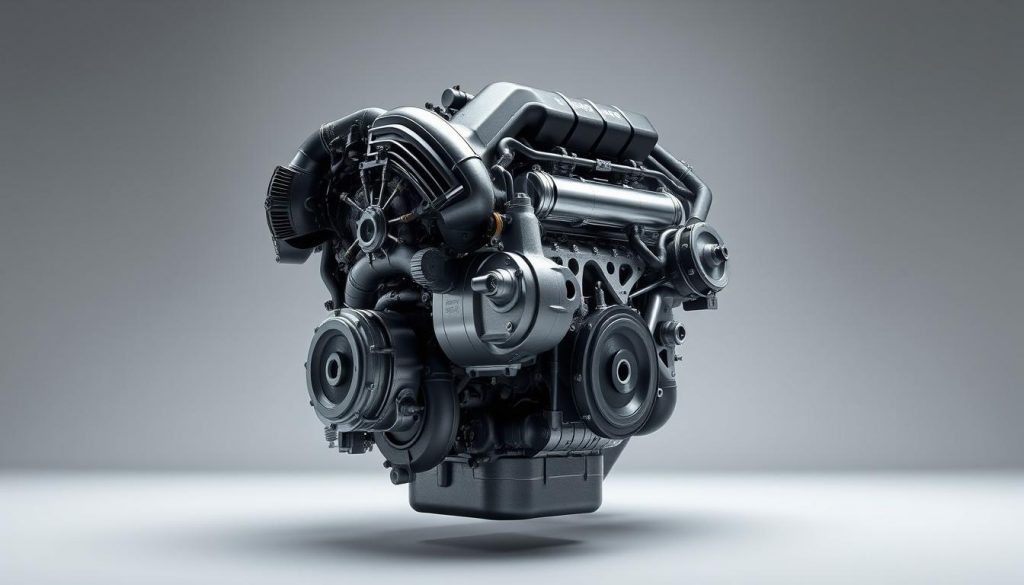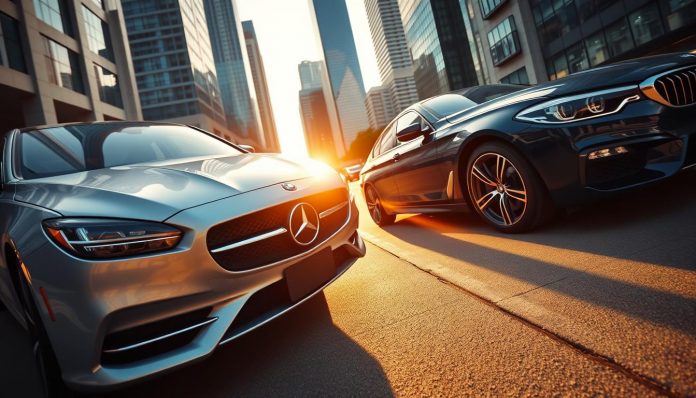Surprising fact: nearly one in three compact cars planned for the next few years could rely on shared four‑cylinder units as manufacturers chase scale and resilience.
The long‑standing rivalry between two German premium makers is giving way to practical pressure from market reality. Talks centre on adopting a proven four‑cylinder family to cover a wide spread of compact and mid‑size car models.
This proposal matters because demand for internal combustion powertrains has stabilised below earlier forecasts, prompting a strategic shift that keeps ICE technology viable into the 2030s. The choice would free one firm to focus R&D on larger six- and eight‑cylinder units while using a mature supply chain to meet volume needs.
The candidate under discussion is BMW’s B48 family, with manufacturing options that include Austria’s Steyr plant and possible US capacity to limit tariff exposure. An official decision is expected before the end of the year, making this a time‑sensitive move in product planning. For background and source detail, see this report: engine deal coverage.
Key Takeaways
- Two leading German companies are considering sharing four‑cylinder units to meet real‑world demand.
- The B48 family is the likely candidate due to packaging flexibility and an established supply chain.
- An end‑of‑year decision would shape compact and mid‑size car launches in the near future.
- Tariff risk and supply‑chain resilience — including possible US production — are central to the talks.
- The deal would let one maker prioritise larger engine development and reduce near‑term R&D costs.
A historic rivalry yields to modern pressures
Market realities are nudging historic competitors towards shared solutions for volume components. The pivot is practical: lower demand for pure EV ranges in premium segments has extended the life of internal combustion plans into the 2030s.
From fierce competitors to pragmatic partners
Decades of head‑to‑head competition in premium car segments have softened. Sharing a compact four‑cylinder engine protects margins across high‑volume cars and lets each firm spend more on flagship technology.
Slowing EV uptake forces a rethink of ICE strategy
One maker stepped back from an EV‑only pledge in 2024. Its CEO said internal‑combustion will persist well into the next decade, which lengthens planning horizons and keeps combustion engines relevant.
| Pressure | Effect | Outcome |
|---|---|---|
| Slower EV uptake | Longer ICE planning | Shared engine use across models |
| Supply‑chain uncertainty | Lower risk via proven supplier | Faster timelines, better margins |
| Regulation & emissions | Need for versatile powertrain | Four‑cylinder fits a wide range |
“Internal‑combustion technology will last well into the 2030s,”
While brand rivalry remains, component‑level partnership makes economic sense. These talks will shape model choices and pricing through the end of the year and influence UK buyers’ options.
Mercedes-Benz & BMW May Collaborate on Engines
Industry reports point to formal negotiations that could reshape compact car powertrains across several model lines.
Core news: according to Autocar magazine, one maker is in advanced talks to adopt the B48 family — BMW’s turbocharged 2.0‑liter inline‑four — as a supply arrangement for future cars. The move would be the first large‑scale cross‑brand powertrain deal between these rivals.
The timeline is clear: an official decision is expected by the end of the year, with market integration pencilled in from around 2027. The B48’s architecture supports both longitudinal and transverse fitment, easing installation across multiple platforms and wheelbases.
- Talks focus on proven four‑cylinder units rather than bespoke development.
- BMW declined to comment when contacted; outreach to Mercedes via email had updates pending.
- If agreed, the deal would scale supply beyond niche partnerships and affect UK car launches.
| Item | Detail | Timing |
|---|---|---|
| Engine family | B48 (turbocharged 2.0‑liter) | Integration ~2027 |
| Talks status | Advanced negotiations per reports | Decision by year‑end |
| Public response | BMW silent; Mercedes response pending email | Limited commentary now |
“This would represent a material shift for two brands known for guarding engineering identities.”
The rationale: why Mercedes-Benz needs a partner — data & figures to include
Volume, tariffs, and packaging explain the search for an external four‑cylinder. A proven unit speeds launches, lowers R&D cost, and avoids the tariff hit linked to China‑built components.
Engine candidate:
Technical fit — the B48 turbocharged 2.0‑litre
The likely powerplant is the B48, a turbocharged 2.0‑litre inline‑four with multiple states of tune. It is engineered for both longitudinal and transverse mounting, so it can be used across front‑drive and rear‑drive platforms.

Production reality
Steyr in Austria already makes B48 units and has spare capacity that could be monetised. A shared engine plant in the US is also under consideration to neutralise tariffs for North American cars.
Model coverage and commercial impact
Target models include the CLA, GLA, GLB, C‑Class, E‑Class, GLC and the future “Little G”. Using a mature engine can cut four‑cylinder R&D spend and free resources for six‑ and eight‑cylinder flagships.
Tariffs, supply chain, and deal timing
Mercedes’ China‑built M252 is reportedly less suited to plug‑in hybrid duty and exposes US‑bound cars to higher duties. A shared engine approach mitigates that risk.
| Aspect | Implication | Metric |
|---|---|---|
| Technical | Longitudinal/transverse fit | B48 turbocharged 2.0‑litre |
| Manufacturing | Monetise Steyr; possible US plant | Higher utilisation / lower tariff cost |
| Market | Covers compact & mid‑size cars | CLA, GLA, GLB, C, E, GLC, Little G |
Outlook: Using a mature engine with established logistics would de‑risk launches and improve margins while allowing brand‑specific calibration and hybrid systems to remain unique.
Conclusion
Cost, capacity and market timing are prompting a rethink that could lead to a joint supply model for compact car engines.
In short: using the B48 family from Steyr — and evaluating a shared US engine plant — is a pragmatic move to balance cost, capability and time as internal combustion remains relevant into the mid‑decade.
For buyers this could also mean broader access to efficient four‑cylinder options across the range and more stable pricing in tariff‑sensitive markets.
If a US engine plant goes ahead, manufacturing resilience improves with shorter supply lines and lower geopolitical risk.
Brand identity is preserved through software, hybrid systems, and model tuning, even if they use BMW engines as a common mechanical base.
Decision timing is critical: talks are advanced and a formal partnership is expected by the end of the year, with rollout around 2027. Communication remains limited — BMW declined to comment, and updates are likely via official statements rather than email.
For more Automotive articles, please follow the link.


